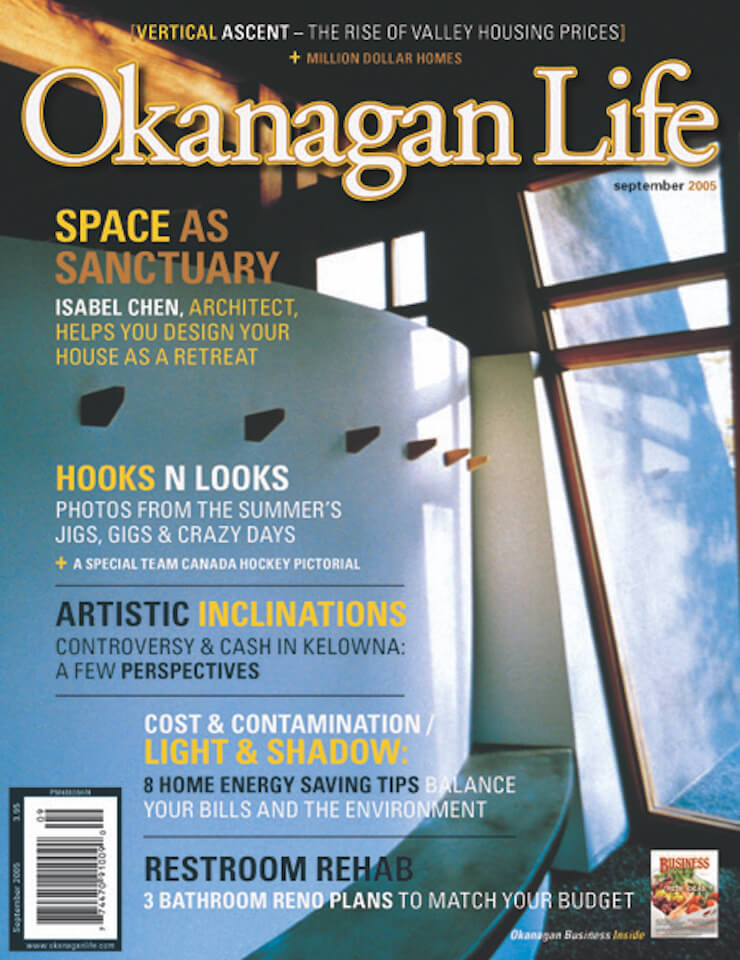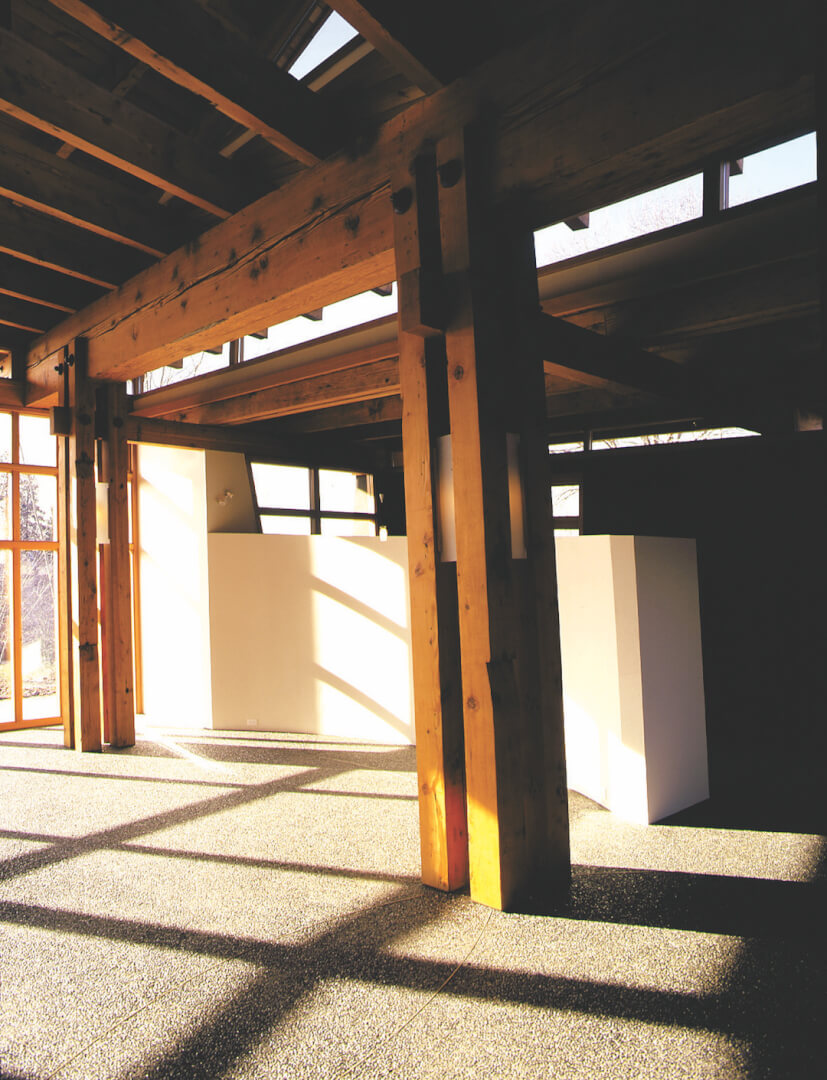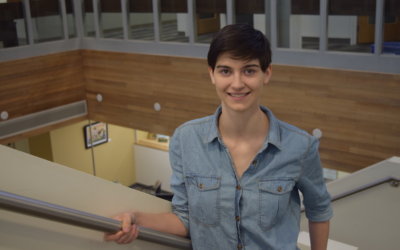A simple, quiet space…for all people who are open to the presence of God’s spirit, to find sanctuary, renewal and recreation, alone or in the community.

By Karen Silvar

I Chen, architect
Be it at home or chapel, she’ll design it as a sanctuary
Telling someone their house is not a home is an insult. By definition, a home is where one lives and a house is a building for human habitation.
When designing a home, there are infinite possibilities. This is where a designer can help.
Penticton architect Isabel Chen believes buildings should grow from and work in harmony with their surroundings. A building’s sculptural form is a response to function, site, client and an unwavering commitment to a design concept, says Chen.
She not only designs homes but other functional buildings as well.
The Chalmers Chapel in Naramata, for example, was designed by Chen. It began with a statement: “A simple, quiet space…for all people who are open to the presence of God’s spirit, to find sanctuary, renewal and recreation, alone or in the community.”
Like a chapel, a home is a sanctuary, says Chen. A custom-designed home must meet the needs of the family who will inhabit it. Of the 53 homes that Chen has designed over the past 14 years, only three families have moved on from them, she says.
Through the design process, clients uncover their needs, what they like and why. A key element in design is to prioritize requirements. The smaller the budget and building, the more need there is for a designer who can maximize on the opportunities, says Chen.
Things to consider when designing a home include the day-to-day activities that occur in your home, whether you cook or work at home if you have children or pets, how often you entertain, how often you have overnight guests and your budget.
More is not necessarily better, says Chen, who has designed homes from 700 up to 7,044 square feet. “I live in a 700 square foot fruit pickers’ cabin and I find it adequate,” says Chen, who lives there with her partner and their dog. “In summertime, visitors bring tents.”
Every building Chen has designed is unique like her clients. The curse of an architect is to be labelled with a style.
Chen takes a holistic approach to design and strives to encompass concepts like solar orientation, lighting both natural and artificial, circulation, ventilation and creative use of space. Her advice is to work with a landscape professional from the beginning of a project.
Many people have told Chen that they could see themselves living in the Chalmers Chapel. The building itself is 1,415 square feet and designed to feel comfortable for one person, as well as a group of 20 people joining hands in a circle of prayer and song.
The chapel is post-and-beam design and uses recycled timbers. The north-south orientation of the building takes advantage of passive solar heating. In the winter, the sun enters the building through the expanse of glass on the south elevation heating the space in addition to the in-slab floor heating. In summer, the sun passes high overhead and the combination of clerestory windows and concrete flooring keep the space cool without the need for air conditioning.
In the future, Chen would like to see “more higher quality small residences” built within existing city infrastructure.
“I love renovation and the idea of reuse,” she said. “A good reno is one that does not look like it’s been done.”
When it comes to building your own home, Chen’s advice is to “do your homework on yourself, on the site and on the neighbourhood and its connections.”
Chalmers Chapel
Size: 1,415 square feet
Cost of construction: $193,430
Building materials:
- Recycled timbers
- Acrylic stucco
- Concrete sink counters
- Exposed aggregate floor with brass circular joints
- Windows and doors made from recycled timber
Completed: 1998 Location: Naramata
Architect: I Chen Architect Builder: Rick Grandbois
Design tips for building your home
- Make your roof work for you by using the space it creates.
- Expose the bones of the structure for honesty.
- Achieve intimate and varied space by using lighting, walls, flooring and different ceiling heights.
- Think of circulation as connective tissue between spaces.
- Bring the outdoors in to expand your interior spaces.
- Design outdoor spaces to extend and maximize their use in spring and fall.
- Make every space a delight to be in especially the laundry room if you do a lot of laundry.
Read more of the original stories celebrated in our 30th-anniversary issue.
Kelowna’s landscape changing forever
“The landscape of Kelowna will forever change in 2018 as homeowners flock to the new downtown towers,” says local realtor and homebuilder A. J. Hazzi, author of The Vantage Report. “We’ll see a vitality on our streets and in the shops and restaurants as the...
Winner declared in Okanagan College 3-Hour Short Story contest
More than 30 budding writers from across the valley put their writing skills to the test in Okanagan College’s 8th Annual 3-Hour Short Story contest and second-year arts student Hannah Stanley has been announced as the overall winner for her original story “The Best...
Kelowna art classes: Kickoff 2018 with a commitment to your creativity
Art classes offered this winter at Kelowna Art Gallery The Kelowna Art Gallery is encouraging you to kick 2018 off with a commitment to your creativity. Registration is now underway for winter art class offerings for adults and youth. The professionally instructed...
Cops for Kids Give $100,000 to Build JoeAnna’s House
The KGH Foundation’s $8 million fundraising campaign to build JoeAnna’s House, a home away from home for families having to travel to Kelowna General Hospital for advanced medical care, received a sizable boost in December with a $100,000 gift from the Cops for Kids...
Family friendly fun for New Year’s
If you’re looking for a place to happen on New Year’s Eve, the annual bash in downtown Kelowna is running for the sixth year in a row. The free family celebration has become a community favourite, and will take place in Stuart Park and in the Kelowna Community Theatre...
As New Year draws near, paint a new you
Registration is open for winter art classes for adults and youth at the Kelowna Art Gallery.





0 Comments